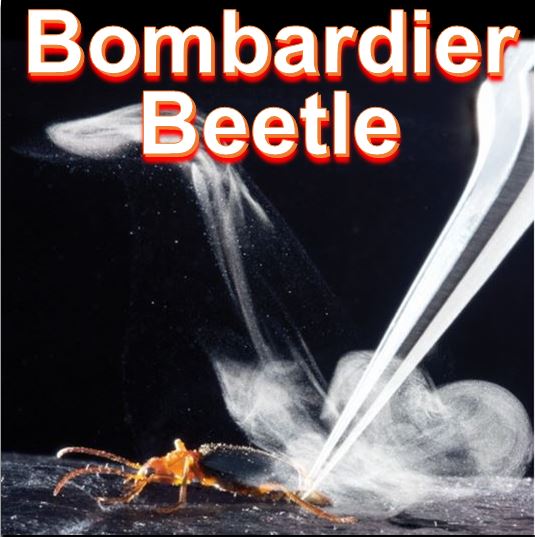How does the bombardier beetle manage to produce an internal explosion which is expelled from its rear end as a jet of super-fast, boiling, irritating liquid towards attackers? Scientists from MIT, the University of Arizona, and the Brookhaven National Laboratory found out how and explained what goes on in the journal Science.
Bombardier beetles exist all over the planet except Antarctica. They have virtually no enemy predator because of their incredibly effective defense mechanism.
For years, scientists have been baffled by the half-inch beetle’s ability to produce and expel this boiling toxic spray without harming itself.

A bombardier beetle ejecting benzoquinone, which is superheated and expelled in an intense, pulsating jet. (Image: MIT)
Dr. Wah-Keat Lee, of Brookhaven National Laboratory; Eric Arndt, a graduate student at MIT; professor of materials science and engineering at MIT, Christine Ortiz; and assistant professor of entomology at the University of Arizona, Wendy Moore, carried out a study and found out why.
“Their defensive mechanism is highly effective – invulnerable to most vertebrates, and invertebrates – except for a few very specialized predators that have developed countermeasures against the noxious spray.”
Bombardier beetles eject a liquid called benzoquinone, which is in fact a quite common defensive agent in the insect world. What makes these beetles unique is their ability to superheat the liquid and expel it with such force, Mr. Arndt explained.
The key is that these beetles synthesize the chemical the moment they need it, by mixing two chemical precursors in a protective chamber in their rear end. As the materials mix to form the irritant, they also give off intense heat that raises the liquid’s temperature nearly to boiling point. This process also generates the pressure required to expel it in a jet.
Looking inside a living beetle
Prof. Ortiz said:
“For decades, the complex mechanism of how the bombardier beetle achieves spray pulsation as a chemical defense has not been understood, because only external observations were used previously.”
In this latest study, the scientists used high-speed synchrotron X-ray imaging at the Argonne National Laboratory to literally ‘look’ inside the abdomens of living bombardier beetles while the explosions occurred.
The detailed images revealed for the first time exactly how the process works. A camera recorded the action at a rate of 2,000 frames per second.
The X-ray images of the explosion showed the dynamics of vapor within the beetles’ abdomens. They revealed that the spray pulsation is controlled by the passageway between two internal chambers. Two structures – a flexible membrane and a valve – control this process.
The closing and opening of this passageway between one chamber holding the precursor liquid and the explosion liquid appears to occur passively – an increase in pressure during the explosion closes the valve when the membrane expands.
After the liquid is ejected the membrane relaxes back to its original state and the passage opens up again, allowing the next pulse to form. All this occurs so rapidly within the insect that the process had never been directly observed.
Not just super hot, also ultra fast
Not only does the explosive mechanism used by the bombardier beetle spray a liquid much hotter than that emitted by other insects that use the same chemical, it also expels it five times faster.
Both the heat and the speed serve to make the spray that much more effective against potential predators, Arndt explained.
The researchers believe the pulsing nature of the spray serves to protect the structure of the beetle’s reaction chamber, giving the chamber walls time to cool a bit before the next blast.
Prof. Ortiz said:
“Understanding the beetles’ ability to survive these intense internal explosions may help in designing blast-protection systems.”
“This study shows how the sophisticated and specialized biological design of the system works to simultaneously achieve defensive and protective functions.”
The reaction chamber, for instance, has a rigid, reinforcing structure to reduce stretching and sustain temperature spikes during an explosion, while other components allow for controlled, reversible stretching and movement to regulate the jet of fluid.
Could this help in propulsion system design?
The scientists believe the dynamics of the spray generation could provide information useful in the design of propulsion systems.
Professor of biology at Cleveland State University, R. Jeffrey Dean, who studies the defense mechanisms of the bombardier beetle, said of this latest study:
“(It is a) wonderful confirmation of the qualitative passive ‘pulse jet’ model” first proposed by his team. Although the findings are not unexpected, I’m amazed at the progressive advances in techniques.”
The study was funded by the National Science Foundation, the National Security Science and Engineering Faculty Fellowship, the Department of Defense (through the US Army Research Office), and the Department of Energy.
Citation: “Mechanistic origins of bombardier beetle (Brachinini) explosion-induced defensive spray pulsation,” Eric M. Arndt, Wendy Moore, Wah-Keat Lee, and Christine Ortiz. Science. Published on 1 May, 2015. DOI:10.1126/science.1261166.
MIT Video – How Bombardier Beetles bomb
This MIT video explains what goes on when the bombardier beetle expels its super hot, noxious substance.

